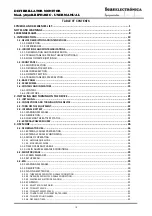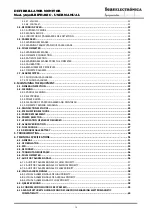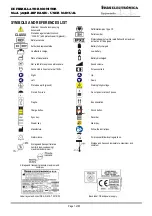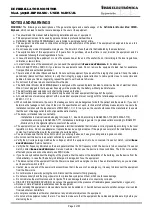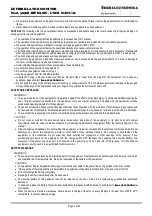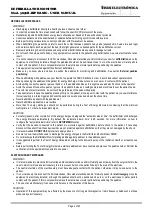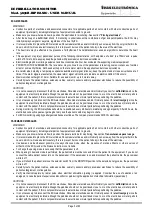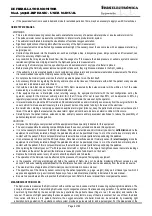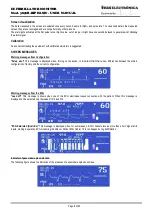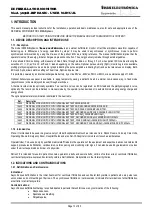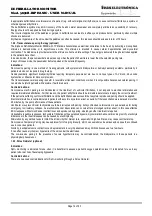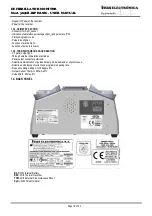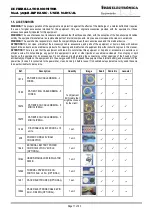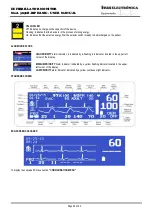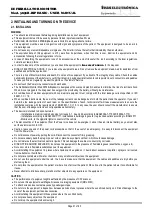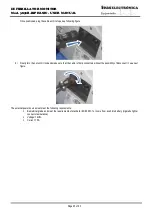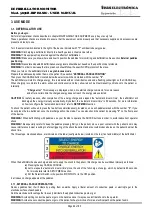
DEFIBRILLATOR MONITOR
Mod. 3850B-BIPHASIC - USER MANUAL
Page 13 of 63
1. INTRODUCTION
This user’s manual provides instructions for the installation, operation and basic maintenance, also for safe and appropriate use of the
DEFIBRILLATOR MONITOR 3850B-Biphasic.
BEFORE YOU START USING THE DEVICE, READ THE MANUAL AND GET FAMILIAR WITH its CONTENT.
1.1. DEVICE DESCRIPTION AND INTENDED USE
1.1.1. Description
The model 3850B-Biphasic of
feas
ELECTRÓNICA
is an external defibrillator monitor of rectilinear biphasic waveform capable of
delivering up to 200Joules of energy, selectable by steps; it may be used in asynchronous or synchronous mode to perform
synchronized cardioversion by using the R-wave of the patient ECG as a timing reference. The manual defibrillation implies that the
operator must set the energy, initiate charge and press shock button. The energy delivery is made through external paddles.
It also allows ECG monitoring, with measure of Heart Rate, through paddles, or through 5 or 3 wires patient ECG cable allowing the
selection of I, II, III, aVR, aVL, aVF and C leads depending on the cable. Optional pulse oximetry (SpO
2
) monitoring is also available,
plotting plethysmographic curve and a bar graph indicating the pulse amplitude, indicating SpO
2
and pulse rate values on display. Both,
ECG and SpO
2
, allows alarms settings of heart rate, SpO
2
and pulse rate.
It is portable, powered by an internal rechargeable battery, by ac line 90Vac - 240Vac, 50Hz or 60Hz, or an external supply of 12Vdc.
Optional transcutaneous pacer is available, to apply temporarily pacing a patient’s heart in external non-invasive way, in fixed mode
(asynchronous) or demand (synchronous) through electrodes.
A thermal recorder is also optionally available. Two real time curves can be registered: an ECG lead and the plethysmographic curve,
optionally. The record can be initialized in manual mode by the operator when decided or in automatic mode during energy charge and
energy shock.
The optional parameters combination is detailed in the next table:
Ref. Description
14634
DEFIBRILLATOR MONITOR WITH INTERNAL BATTERY 3850B BIPHASIC.
14635
DEFIBRILLATOR MONITOR WITH INTERNAL BATTERY AND RECORDER 3850B BIPHASIC/R.
14636
DEFIBRILLATOR MONITOR WITH INTERNAL BATTERY AND PACER 3850B BIPHASIC/TPM.
14637
DEFIBRILLATOR MONITOR WITH INTERNAL BATTERY, RECORDER AND PACER 3850B BIPHASIC/R/TPM.
14638
DEFIBRILLATOR MONITOR WITH INTERNAL BATTERY AND SpO
2
3850B BIPHASIC/SpO
2
.
14639
DEFIBRILLATOR MONITOR WITH INTERNAL BATTERY, RECORDER AND SpO
2
3850B BIPHASIC/R/SpO
2
.
14640
DEFIBRILLATOR MONITOR WITH INTERNAL BATTERY, PACER AND SpO
2
3850B BIPHASIC/TPM/SpO
2
.
14641
DEFIBRILLATOR MONITOR WITH INTERNAL BATTERY, RECORDER, PACER AND SpO
2
3850B BIPHASIC/R/TPM/SpO
2
.
1.1.2. Intended Use
Place: It is intended to be used in a great variety of clinical/hospital ambient such as Intensive Care, Shock Rooms, Coronary Care Units,
Operating Rooms, Emergency Room, Hospital Wards and also Out-Of-Hospital or in mobile units such as ambulances.
Operator/User: To be used only by qualified medical staff trained in the operation of the equipment and expertise in advanced cardiac life
support, procedures defibrillation, cardioversion, cardiac pacing and monitoring vital signs. It can also be used by paramedics or nurses
under the direct supervision and order of a physician.
Patient: It is intended for used in patient neonates, pediatric, adults and senior adults; victims of cardiac arrest, ventricular fibrillation,
ventricular tachycardia, supraventricular tachycardia, atrial fibrillation, bradycardia or other fatal arrhythmias.
1.2. INDICATIONS AND CONTRAINDICATIONS
1.2.1. Defibrillation and Cardioversion
Indications:
Asynchronous defibrillation is the initial treatment for ventricular fibrillation and ventricular tachycardia in patients who are pulse less,
unconscious and not breathing on their own. The synchronous fibrillation or cardioversion is indicated for termination of atrial fibrillation,
atrial flutter or atrial tachycardia.
Contraindications:
Asynchronous defibrillation therapy is contraindicated in patients that exhibit one or any combination of the following:
•
Responsiveness.
•
Spontaneous breathing.
•
Palpable pulse.

